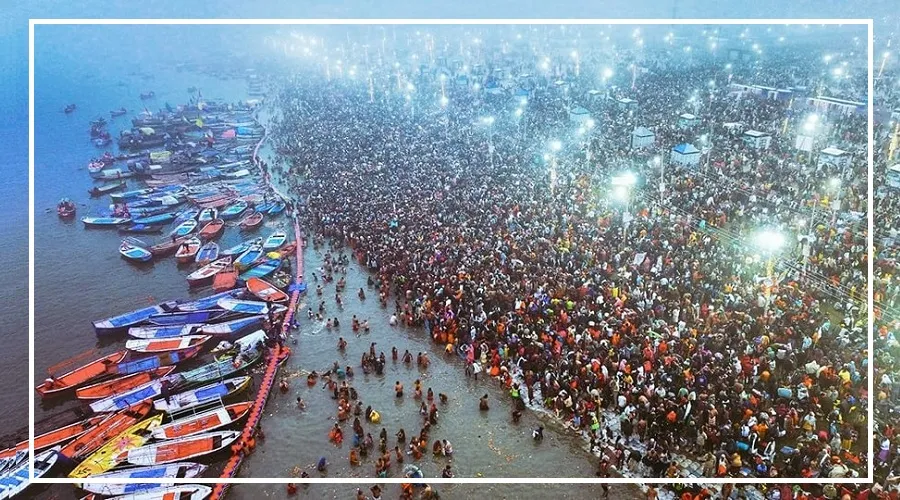The Ganga water at the Triveni Sangam in Prayagraj, where millions are taking a holy dip during the Maha Kumbh, has been declared unsafe for bathing due to high Biological Oxygen Demand (BOD) levels. BOD is a key indicator of water quality.
Government data, as reported by PTI, confirms that BOD levels have surpassed the permissible limit.
What is BOD?
BOD measures the oxygen required by aerobic microorganisms to break down organic matter in water.
Higher BOD levels indicate increased organic pollution, making the water unsuitable for bathing.
Water is deemed safe for bathing when BOD levels are below 3 milligrams per litre.
The Central Pollution Control Board (CPCB) recently informed the National Green Tribunal that several locations in Prayagraj do not meet the primary bathing water quality standards due to high faecal coliform levels.
However, it stated that after January 13, the BOD levels met the bathing criteria due to freshwater inflow from upstream locations.
Despite this, current government data indicates that the BOD levels at Sangam still exceed safe limits.
On February 16, at 5 am, the BOD level at Sangam was 5.09 milligrams per litre.
It was recorded at 4.6 milligrams per litre at 5 pm on February 18 and increased to 5.29 milligrams per litre by 8 am on February 19.
According to CPCB data, the BOD level at Sangam was 3.94 milligrams per litre on January 13, when the Maha Kumbh began.
It improved to 2.28 milligrams per litre on Makar Sankranti (January 14) and dropped to 1 milligram per litre on January 15.
However, it rose again to 4.08 milligrams per litre on January 24 and was recorded at 3.26 milligrams per litre on Mauni Amavasya (January 29).
To maintain safe bathing conditions, the Uttar Pradesh government is releasing 10,000 to 11,000 cusecs of water into the Ganga.
Maha Kumbh 2025
The Maha Kumbh, which started on January 13, will conclude on February 26, Maha Shivaratri day.
Over 54 crore people have taken a dip in the sacred waters of Triveni Sangam so far.
Mahakumbh Nagar, the world’s largest temporary city, accommodates between 50 lakh and 1 crore devotees at any time.
These pilgrims generate approximately 16 million litres of faecal waste and 240 million litres of greywater daily from cooking, washing, and bathing.
Uttar Pradesh Chief Secretary Manoj Kumar Singh stated that increased pilgrim numbers result from the government’s improvements in water quality and sanitation since the 2019 Ardh Kumbh.
“Before 2019, there were no toilets at Kumbh. Officials designated areas with red flags and provided tents, leading to open defecation.
In 2019, we constructed 1.14 lakh individual toilets with Sintex (plastic) tanks to collect waste.
These were desludged every two to three days and transported to distant oxidation ponds.
This year, we have built 1.5 lakh individual toilets and established two faecal sludge treatment plants,” he said.
Singh also mentioned a 200 km-long temporary drainage system connecting treatment facilities.
“Sanitation is a key feature of Kumbh arrangements, and those who have attended previous Kumbhs can clearly see the difference,” he added.
Himanshu Thakkar, coordinator of the South Asia Network on Dams, Rivers, and People (SANDRP), criticized the state government for claiming the water is safe despite evidence to the contrary.
“Providing clean water for bathing is the government’s responsibility. When water is unsafe, the risk of infections increases significantly,” he warned.
National Green Tribunal Report
The National Green Tribunal was informed on Monday, via a CPCB report, that several locations in Prayagraj during the ongoing Maha Kumbh do not meet the primary bathing water quality standards due to high faecal coliform levels, PTI reported.
Faecal coliform, an indicator of sewage contamination, has a permissible limit of 2,500 units per 100 ml, according to the CPCB.
Since 2015, India’s rivers have become increasingly polluted. That year, the CPCB identified 302 polluted river stretches spanning over 12,000 km nationwide.

























